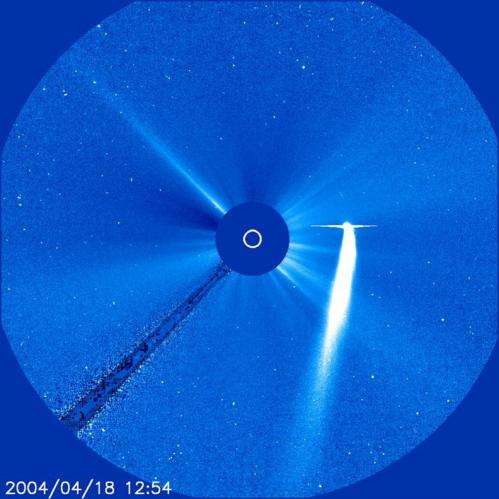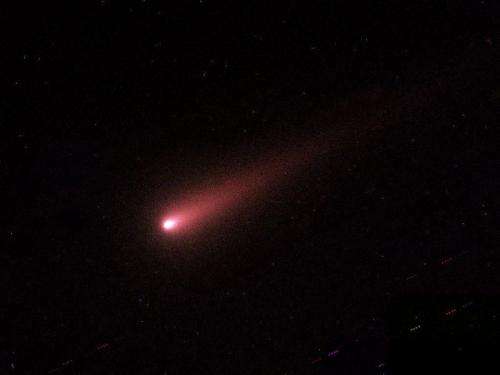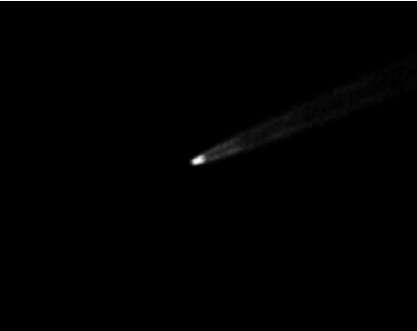Fossil from the depths of the solar system

(Phys.org) —ISON is approaching the Sun. An international observation campaign which involves ground-based telescopes, space probes and space telescopes has been running for some time and is already providing initial findings. The comet is now in the sights of the STEREO twin probes which monitor our Sun and how it affects the space weather from their orbits. The Max Planck Institute for Solar System Research in Katlenburg-Lindau is also integrated into the scientific activities.
Having passed Mars by a few weeks ago, comet ISON is now entering the last stage of its journey to the Sun: on 28 November the comet will hurtle past the Sun at a distance of just over one million kilometres. In the days after it has passed by the Sun, ISON could develop into a spectacular phenomenon in the night sky which can easily be seen with the naked eye.
"ISON combines two properties which make it a real stroke of luck for research," says comet researcher Hermann Böhnhardt, who heads the ISON activities at the Max Planck Institute for Solar System Research. ISON will come very close to the Sun, for one. At surface temperatures of up to 2000 degrees Kelvin, metals and other substances could vaporize instead of remaining bound up in the comet material, as is usually the case. Here, they are inaccessible to investigations undertaken with telescopes - and are thus largely unknown as yet.
On the other hand, ISON was already surprisingly bright when it was discovered a year ago. The observations of recent months have put a damper on the expectations a little, however: the brightness of the comet has not increased as strongly as was initially thought. Nevertheless, even the most recent predictions expect the comet will probably remain an object that is unusually easy to see and worthwhile observing.
Moreover, there are many indications that the comet, which can already be clearly seen on the images of ground-based and space-based telescopes, is possibly now advancing into the inner solar system for the first time. Its trajectory is so elongated that it has apparently remained hidden in the depths and cold of space for most of his life since it was born billions of years ago. This is also fortunate. "These so-called non-periodic comets contain uncontaminated information from the birth of our solar system," says Böhnhardt.
ISON is a fossil from the time our planetary system was born, more so than bodies such as Halley's Comet, whose significantly smaller elliptic trajectories regularly lead them up close to the Sun. While the inner planets changed gradually, partly due to the influence of the Sun, and developed into solid bodies with a dearth of gas and water, the original conditions remained conserved in the cometary ice at the edge of the solar system.

The latest observations indicate that the debutant possesses a further special feature: its axis of rotation seems to be pointing towards the Sun. In this constellation, one side of the comet is permanently turned away from the hot, seething destination on its approach to the Sun. Only when ISON's trajectory begins to curve more pronouncedly at the end of November will this material be heated up as well.
The Max Planck researchers also hope to find indications of ISON's organic composition in the original substance of the comet. Organic compounds such as methanol, ammonia and formaldehyde are among the main components of the mineral and organic mass of the comet. Many researchers therefore assume that cometary impacts also brought these molecules and thus the fundamental building blocks of life to Earth.
As the comet approaches the Sun, the volatile organic substances vaporise or are ejected into space with the dust particles. A more detailed look at the coma - the atmosphere of the comet - thus allows conclusions to be drawn about its interior. In January, the Max Planck researchers want to take just such a look at ISON with the telescopes on Mount Mauna Kea (Hawaii). "Organic molecules leave characteristic fingerprints in the light that the comet's coma reflects into space," explains Böhnhardt. If light is dispersed into its spectral components, these can be detected.
The scientist is particularly interested in the mixing ratio of the molecules: "We can assume that the ratio depends on the location where the comet was formed." If it proves possible to obtain the molecular compositions for several comets of very different origin, researchers would then be able to reconstruct how these substances were distributed in the early solar system.
The Max Planck Institute for Solar System Research has already turned its attention to the properties and the development of ISON's dust tail. Initial photos, which Nilda Oklay succeeded in taking in recent days at the Turkish National Observatory near Antalya, show a distinctly homogeneous envelope of gas and dust behind which the comet nucleus is hiding.
"If sudden eruptions of gas and particles take place at the comet's surface, or if only small areas are permanently active, we can usually make this visible in our evaluations of the images," explains the Max Planck researcher Jean-Baptiste Vincent. In his computations, he reduces the brightness of the coma at every position by the same averaged value. This then brings structures into view, and these enable conclusions to be drawn about when and where the comet emits dust.

With ISON, however, these computations have so far not turned up any structures. "The only thing is that the side turned towards the Sun exhibits greater activity than the dark side," is Vincent's conclusion. One explanation could be that gas and dust vaporise uniformly from the whole surface. Since the comet has possibly never been subjected to the influence of the Sun, it could still be enveloped in its original blanket of ice. Comets which regularly visit the inner solar system paint a different picture, however: usually, only a small percent of the surface is actively producing dust.
The researchers were also able to coax information about the size and speed of the dust particles out of their images - albeit indirectly. "On the computer we calculate what the dust tail of the comet must have looked like at various points in time. We do this by varying certain parameters, such as the size of the emitted dust particles and their speed, until the computed image looks similar to the one taken," explains Jean-Baptiste Vincent. The scientists can then venture to take a look into the future with these data and compute what the dust tail should look like in a few weeks.
For the days immediately after it has flown past the Sun, the scientists expect a tail that has fanned out broadly and should be clearly visible. "The condition is that ISON survives the fly-by, however," points out Hermann Böhnhardt, as the celestial body could break up under the influence of the heat and the gravity of our Sun. Although this would be a disappointment for many amateur astronomers, who have been eagerly awaiting the visitor initially celebrated as the "comet of the millennium" for months, it would not be the worst turn of events from the point of view of many researchers. On the contrary.
ISON would grant the solar probes STEREO and SOHO, in particular, which will enjoy a particularly good view of the events during the hours and days before and after the fly-by, an even more detailed look into its heart - and this would become a further stroke of luck for comet research.
Provided by Max Planck Society





















